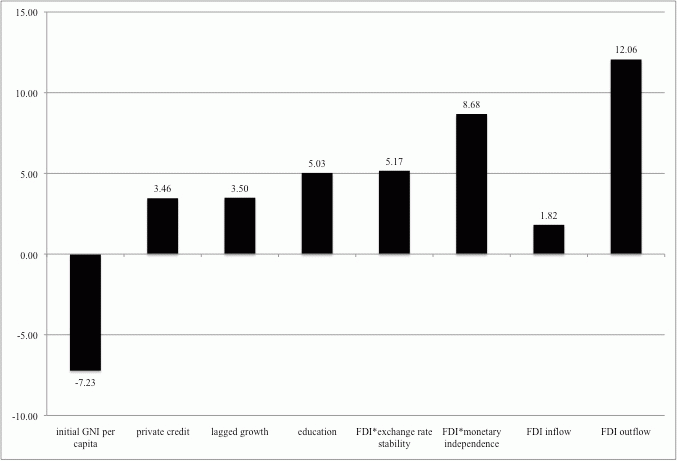The global financial and economic crisis of 2008–09 marks an opportune time to revisit the issue of international financial integration.
- The crisis raised the possibility that financial integration went too far, reinvigorating the debate about the desirability of a laissez-faire approach towards financial integration (Stigliz 2010)
- Going forward, the spectre of large and volatile capital flows is raising concerns in emerging markets about their adverse and destabilising impact on financial stability and economic growth.
The relationship between financial openness and economic growth remains the subject of heated controversy.
In contrast to the largely positive perception of trade integration, economists differ sharply about the effect of financial integration on growth. In principle, access to foreign savings can promote investment and growth in recipient countries, and access to a wider range of investment opportunities can contribute to more efficient investments and thus growth in the source countries. In practice, however, the international historical experience fails to yield convincing evidence of a positive relationship between financial integration and growth. To the contrary, countries such as China and India have grown rapidly despite a limited degree of financial integration. In addition, even on purely theoretical grounds, financial integration may entail negative growth and welfare effects. Financial integration in the presence of distortions and externalities can lead to sizeable welfare costs in the worst case scenarios.1
Integration of emerging markets into global financial markets is a relatively recent phenomenon. Financial integration among advanced countries took off and progressed rapidly since the end of the Bretton Woods system. By and large emerging markets maintained varying degrees of restrictions on their capital accounts until the early 1990s. In a remarkable turnaround since then, emerging markets joined the global trend towards financial integration, although at a more controlled pace than the headlong rush of advanced economies. In light of the heterogeneous nature of capital flows, it may not be sensible to lump them together in investigating the impact of capital flows on economic growth. FDI and portfolio equity investment are fundamentally different from each other since the former is associated with ownership and control while the latter is not. Both are different from foreign debt that creates liabilities which must be repaid. Therefore, there is no a priori reason why different types of capital flows should have the same effect on growth.
The crisis thus provides strong fresh impetus for empirically revisiting the relationship between international capital flows and economic growth. To do so, in a new paper (Aizenman et al 2011) we look at macro data for 1990–2010, a period which encompasses growing financial integration of emerging markets, low volatility associated with the Great Moderation in advanced economies, and the global financial crisis. We investigate the relationship between economic growth and lagged international capital flows, disaggregated into FDI, portfolio investment, equity investment, and short-term debt, controlling for a vector of the relevant macro variables. These variables include real GDP per capita, initial GNI per capita, private credit–GDP ratio, education, measures of exchange stability and monetary independence, and the amounts of different types of capital flows. The types of capital flows we study are FDI, portfolio investment, equity investment, and short-term debt. Our sample covers about 100 countries for which data was available. Our central objective is to look for systematic patterns in the relationship between capital flows and growth during a period of financial integration. In addition, we compare the pre-crisis period, 2000–05, with the immediate pre-crisis and the crisis period, 2006–10.
Empirical results
Our results indicate that FDI flows – both inflows and outflows – are positively associated with economic growth, especially when exchange rates are stable and monetary policy independent. In contrast, portfolio investment and the growth of equity investment associations with growth are statistically insignificant. In addition, the standard macro controls included are statistically significant with expected signs. The growth rate of GDP per capita is persistent – the lagged dependent is positive and statistically significant. There is convergence across countries as the coefficient on initial GNI per capita is negative. Financial depth leads to higher growth – the variable private credit/GDP is positive. Education is also found to be good for growth.
We summarise the economic significance of each variable in Figure 1. Increasing the growth of private credit/GDP by one standard deviation increases GDP-per-capita growth by 3.5 percentage points. The growth of FDI outflows and its interactions with improvement in exchange-rate stability and monetary independence have the largest positive effect on the growth rate of GDP per capita. Initial GNI per capita has a large negative effect, implying strong convergence between rich and poor countries.
Figure 1. Economic significance of a one standard deviation increase on the percentage growth rate of the GDP per capita
Is the global crisis episode any different?
We divide our sample into two five-year periods; the pre-crisis years of 2001–05 and the crisis years of 2006–10 and run both cross section and panel estimations. Subject to data availability, we also consider the short-term external debt to GDP ratio as another measure of hot capital flows. The pre-crisis panel estimation yields a similar pattern to the cross-country estimation. Both lagged FDI inflows and lagged equity investments are associated with higher GDP per capita, while the association between economic growth and short-term debt flows is insignificant. During the crisis period, the associations between the growth of GDP per capita on one hand and FDI and equity investment on the other hand remain positive and significant. During the crisis period of 2006–10, countries with weaker institutions suffered more from short-term external debt. Short-term debt had a sizable negative impact on growth in the crisis period but no impact in the noncrisis period.
Concluding remarks
There are growing concerns in emerging markets that large and volatile capital inflows will harm their financial systems and real economies. Historical experiences of capital-inflow bonanzas which created short-term booms but eventually led to crises lend further weight to such concerns. Our empirical results thus provide some support for the popular perception that FDI is more beneficial for growth than other types of inflows.These results are also consistent with sectoral level evidence from Aizenman and Sushko (2011) who examined the differential impact of portfolio debt, portfolio equity, and FDI inflows on 37 manufacturing industries in 99 countries over 1991–2007. Net portfolio debt inflows were found to be negatively associated with growth during the mid-1990s. Surges in portfolio equity inflows also exhibit a negative association with aggregate growth in the manufacturing sector.
The results also support our earlier observation that in recent decades some fast-growing emerging markets, especially those in East Asia, enjoyed current-account surpluses. This stylised fact is inconsistent with the notion that the main economic benefit of capital inflows is that they help to ease shortages of savings and thus allow for greater investment and faster growth. This suggests that the primary gain from financial integration is not access to pool of foreign savings but instead access to other foreign factors of production. Much more than other forms of capital inflows, FDI is bundled together with other factors which can promote growth such as advanced foreign technology and know-how. Another interesting result, especially in light of the rising importance of emerging markets as sources of FDI, is that FDI outflows too are associated with a positive effect on growth.
The sceptical popular view about the benefits of non-FDI capital inflows for economic growth is in line with our results. In contrast to FDI, portfolio investment, equity investment, and short-term debt do not bring obvious benefits other than access to foreign savings. For our sample of countries as a whole, portfolio and equity investment do not have a significant effect on growth. Our results lend some support to the notion that short-term foreign debt can adversely affect growth.
At a broader level, the results of our empirical analysis of the capital flows–growth nexus during an era of financial integration and crisis confirm the need for policymakers to differentiate between different types of capital flows. Although global financial integration since 1990 has taken the form of both FDI and non-FDI capital flows, according to our analysis only FDI has a strong and robust positive effect on growth. Therefore, in the context of post-crisis discussions in emerging markets about managing capital inflows, our findings support the need for selective and targeted policies. In addition, our evidence suggests that the effects of capital flows may differ between crisis and noncrisis periods. In particular, short-term debt has no effect in noncrisis periods but a sizeable adverse effect in crisis periods. Policymakers may thus have to also differentiate between crisis and noncrisis periods.
References
Aizenman, Joshua (2004), “Financial Opening: Evidence and Policy Options,” Challenges to Globalisation, Baldwin, R, and A Winters (eds). Chicago: University of Chicago Press.
Aizenman, Joshua, Yothin Jinjarak, and Donghyun Park (2011), “Capital Flows and Economic Growth in the Era of Financial Integration and Crisis, 1990-2010”, NBER Working paper 17502.
Aizenman J and V Sushko (2011), “Capital Flow Types, External Financing Needs, and Industrial Growth: 99 countries, 1991-2007”, NBER Working Paper 17228.
Blair, Henry Peter (2003), “Capital-Account Liberalization, the Cost of Capital, and Economic Growth,” American Economic Review 93(2): 91-96.
Gourinchas PO and O Jeanne (2006) “The Elusive Gains from International Financial Integration”, Review of Economic Studies 73(3): 715-741.
Hellmann, Thomas F, Kevin C Murdock, and Joseph E Stiglitz (2000), “Liberalization, Moral Hazard in Banking, and Prudential Regulation: Are Capital Requirements Enough?” American Economic Review (90)1: 147-165.
Stiglitz, Joseph E (2010), “Risk and Global Economic Architecture: Why Full Financial Integration May Be Undesirable”, NBER Working Paper 15718.
1 See Hellmann et al (2000) and the references therein for the welfare implications of financial integration in the presence of distortions, and Aizenman (2004) for further references and overview of the debate regarding the merits of financial integration. Gourinchas and Jeanne (2006) report that measured welfare gains from switching from financial autarky to perfect capital mobility are negligible relative to the potential welfare gain of a takeoff in domestic productivity of the magnitude observed in some of the emerging markets.





